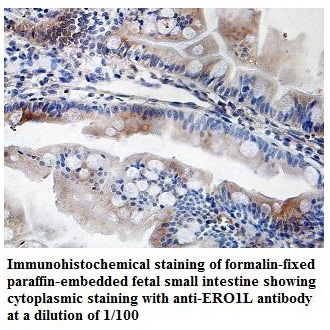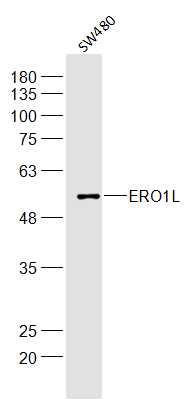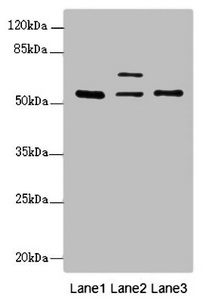ERO1L antibody
GTX112589
ApplicationsImmunoFluorescence, Western Blot, ImmunoCytoChemistry, ImmunoHistoChemistry, ImmunoHistoChemistry Paraffin
Product group Antibodies
TargetERO1A
Overview
- SupplierGeneTex
- Product NameERO1L antibody
- Delivery Days Customer9
- Application Supplier NoteWB: 1:500-1:3000. ICC/IF: 1:100-1:1000. IHC-P: 1:100-1:1000. *Optimal dilutions/concentrations should be determined by the researcher.Not tested in other applications.
- ApplicationsImmunoFluorescence, Western Blot, ImmunoCytoChemistry, ImmunoHistoChemistry, ImmunoHistoChemistry Paraffin
- CertificationResearch Use Only
- ClonalityPolyclonal
- Concentration0.95 mg/ml
- ConjugateUnconjugated
- Gene ID30001
- Target nameERO1A
- Target descriptionendoplasmic reticulum oxidoreductase 1 alpha
- Target synonymsERO1-L, ERO1-L-alpha, ERO1-alpha, ERO1L, ERO1LA, Ero1alpha, ERO1-like protein alpha, endoplasmic oxidoreductin-1-like protein, endoplasmic reticulum oxidoreductase alpha, oxidoreductin-1-L-alpha
- HostRabbit
- IsotypeIgG
- Protein IDQ96HE7
- Protein NameERO1-like protein alpha
- Scientific DescriptionEssential oxidoreductase that oxidizes proteins in the endoplasmic reticulum to produce disulfide bonds. Acts by oxidizing directly P4HB/PDI isomerase through a direct disulfide exchange. Does not act as a direct oxidant of folding substrate, but relies on P4HB/PDI to transfer oxidizing equivalent. Associates with ERP44 but not with GRP54, demonstrating that it does not oxidize all PDI related proteins and can discriminate between PDI and related proteins. Its reoxidation probably involves electron transfer to molecular oxygen via FAD. Acts independently of glutathione. May be responsible for a significant proportion of reactive oxygen species (ROS) in the cell, thereby being a source of oxidative stress. Required for the folding of immunoglobulin proteins. Responsible for the release of the unfolded cholera toxin from reduced P4HB/PDI in case of infection by V.cholerae, thereby playing a role in retrotranslocation of the toxin.
- Storage Instruction-20°C or -80°C,2°C to 8°C
- UNSPSC12352203
References
- Zilli F, Marques Ramos P, Auf der Maur P, et al. The NFIB-ERO1A axis promotes breast cancer metastatic colonization of disseminated tumour cells. EMBO Mol Med. 2021,13(4):e13162. doi: 10.15252/emmm.202013162Read this paper
- Chen JF, Tsai YT, Lai YH, et al. Proteomic analysis of Antrodia Cinnamomea-induced ER stress in liver cancer cells. J Pharm Biomed Anal. 2020,187:113142. doi: 10.1016/j.jpba.2020.113142Read this paper
- Wang SH, Cheng CY, Chen CJ, et al. Acute Heat Stress Changes Protein Expression in the Testes of a Broiler-Type Strain of Taiwan Country Chickens. Anim Biotechnol. 2019,30(2):129-145. doi: 10.1080/10495398.2018.1446972Read this paper
- Huang HJ, Lin CC, Chou HC, et al. Proteomic analysis of rhein-induced cyt: ER stress mediates cell death in breast cancer cells. Mol Biosyst. 2014,10(12):3086-100. doi: 10.1039/c4mb00451eRead this paper







